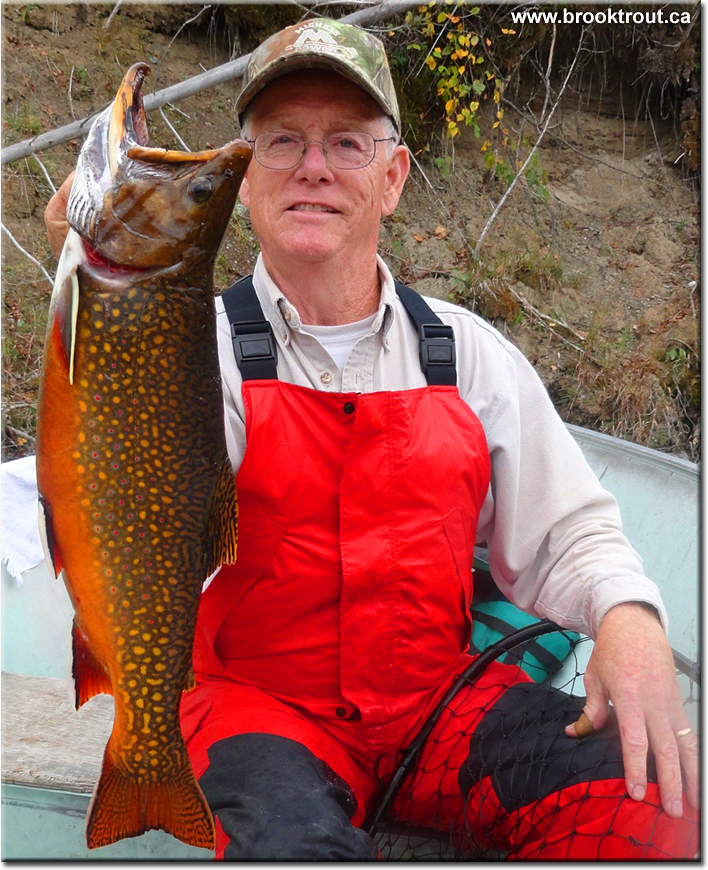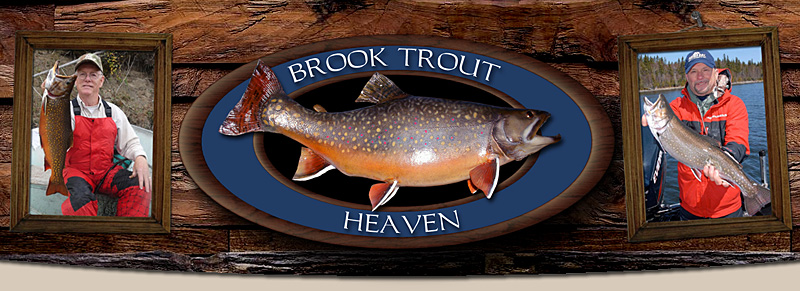Brook Trout Biology
 Salvelinus Fontinalis
Salvelinus Fontinalis
This salmonid is also called brook trout, brook charr, brookie, squaretail, sea-trout, Eastern brook trout, coaster, and breac.
Distribution
The speckled trout is native to eastern North America from the Atlantic seaboard to Massachusetts, south along the Appalachian Mountains, west to Minnesota and north to Hudson Bay. It is found in a range of waters from tiny ponds to large rivers, lakes, and salt water estuaries. Its popularity as a sport fish has resulted in speckled trout introductions throughout the world. Widely distributed throughout the Maritimes, speckled trout are our most sought-after freshwater fish.
Physical Characteristics
The speckled trout is a handsome fish. Like salmon, their colour varies depending on the water they are in and their sexual activity. Here are some common characteristics:
Adult in freshwater are green to dark brown and black on the back and sides. They have light-coloured wavy lines on upper back, dorsal fin and upper part of the caudal (tail) fin. Red spots surrounded by blue halos and many light spots are usually present on the sides.
The belly is lighter, white to yellow in females, or reddish in males. The leading edges of the lower fins have a bright white border followed by a black border and reddish coloration.
During spawning colours intensify and males can become a deep orange-red on the belly.
Adults in saltwater are silvery on the sides and dark blue or green on the back. Pale red spots may be visible on the sides as well as the white leading edge on the fins. When returning from the sea, these trout re-acclimate to their freshwater environment and regain their colours.
Young speckled trout or parr have 8 - 10 dark vertical bars (called parr marks) on the sides.
Facts About Speckled Trout
Larger speckled trout that live in northern waters sometimes eat small mammals such as mice, shrews, and voles.
A 61 cm (24 in) sea-run speckled trout that weighed 3.4 kg (7.5 lb) was caught in Halifax County, Nova Scotia, in 1871. It can be seen today in the Nova Scotia Museum of Natural History.
In more recent times, sea-run speckled trout as long as 66 cm (26 in), weighing 3.2 kg (7.0 lb), have been caught on Cape Breton Island.
The largest "brookie" on record was taken in Ontario in 1915, weighing 14.5 lb (6.6 kg) and measuring 34 in (86 cm) long.
Natural History
Speckled trout prefer cool clear waters of 10 - 18C with a lot of cover. Usually they live in spring-fed streams with many pools and riffles. There they use undercut banks, submerged objects such as large rocks, tree trunks and stumps, deep pools, and shelter from overhanging vegetation as hiding places. Speckled trout are mostly meat-eaters (carnivorous). They eat many water and land insects such as mayflies, caddis flies, midges and beetles. Larger trout eat leeches, small fish, mollusks, frogs, and salamanders.
Speckled trout in Nova Scotia spawn during October and November in shallow, gravelly areas of streams with clean bottoms and good water flows. Spring-fed headwaters are ideal, but they will also spawn in the gravel-bottomed areas of lakes where spring waters occur. The female digs a nest (redd) 10 - 15 cm (4-6 in) deep in the gravel with her body.
After the eggs have been laid and fertilized, they are covered and left to develop slowly over the winter. A 25 cm (10 in) female trout can produce about 500 3 - 5 mm eggs. Water flowing through the redds keeps the eggs clean and oxygenated. Hatching occurs in the spring and the larvae (alevins) remain still and undisturbed in the gravel while they absorb the large yolk-sac.
Young trout (fry) emerging from the gravel have lengths of 2.5 - 3.5 cm (1 in +) and begin feeding on aquatic insects. They prefer shallow areas where temperatures are 11 - 15 C and where rubble (rocks of 10 - 40 cm or 4 - 16 in) on the stream bottom provides cover. At the end of their first year, speckled trout in Nova Scotia are 5 - 10 cm (2 - 4 in) long. They overwinter on the stream bottom in spaces between rocks. The best rock sizes for their first several winters are in the 25 - 40 cm (10 - 16 in) range. Their growth depends very much on local conditions. Speckled trout living in large rivers and lakes would probably be 25 or 30 cm (10 - 12 in) at age 3, but those in small streams might only reach a length of 15 cm (6 in).
Trout usually mature at three years old and rarely live past age 5.
Some populations of speckled trout migrate to sea for short periods. They move downstream and upstream in the spring or early summer and remain in estuaries and ocean areas where food is plentiful. After about 2 months they return to freshwater.
Speckled trout probably migrate to sea in response to crowded conditions, low food supplies, or unfavourable temperatures in their home waters. Some over-winter in estuaries, and there are shore movements along our coast. Not all fish in a population migrate, nor do they necessarily go every year. Sea-run speckled trout live longer and grow larger than strictly freshwater speckled trout.
Predators include mergansers, herons, kingfishers, mink, owls, osprey, bald eagles, otter, perch, eels, other trout, and man.




 Salvelinus Fontinalis
Salvelinus Fontinalis